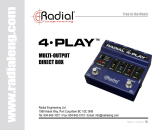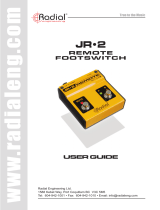
PZ-Pro™
Radial Engineering Ltd.
12
THE TUNER OUT AND MUTE FOOTSWITCH
The PZ-Pro is equipped with a Mute Footswitch and a
dedicated buered Tuner output for quiet on-stage tuning
without disrupting the performance. Use a standard 1/4"
TS instrument cable to connect a tuner pedal to the PZ-
Pro Tuner Out: This will send either Input-A or Input-B
directly to your tuner depending on which channel is active
(or both inputs if you have the A+B switch engaged).
The Tuner
output
The Amp
output
The Mute Footswitch
When the Mute Footswitch is engaged, the red LED
next to the switch illuminates and all of the PZ-Pro
outputs are turned o except the Tuner output. This
also allows you to connect a dierent instrument
to one of the PZ-Pro inputs without causing pops
through the PA or the stage amplier.
The 1/4" Amp output on the PZ-Pro is provided for feeding
an on-stage amplier or other instrument-level devices
such as amp modelers or additional eects pedals. This
output mirrors the Post EQ XLR output, so it includes all
EQ & Filter settings, as well as the FX Loop and Boost
controls when they are engaged. The Mute Footswitch
cuts signal to this output.
The Post EQ XLR Out takes a signal that is after (Post) the EQ, FX
and Boost features, providing an aected 'wet' signal that is perfect for
feeding a monitor mix system or a powered PA monitor for gigs without a
dedicated sound engineer.
THE PZ-PRO OUTPUTS CONTINUED
Each XLR output has a dedicated
180° and Ground Lift switch ° °
Each XLR output includes two
additional features: a 180° switch
and a Ground Lift. The 180° switch
reverses the polarity at the XLR output
to help phase-align signals when this
output is mixed together with the
signal from a mic'd up stage amplier.
The 180° switch can also help reduce
feedback on stage with acoustic
instruments.
The Ground Lift switch disconnects pin-1 audio ground on the XLR
output, which can help reduce hum and buzz that occurs due to ground
loops. If you encounter ground loop noise when the PZ-Pro is connected,
engaging the Ground Lift on each connected output can help alleviate
this issue.





















